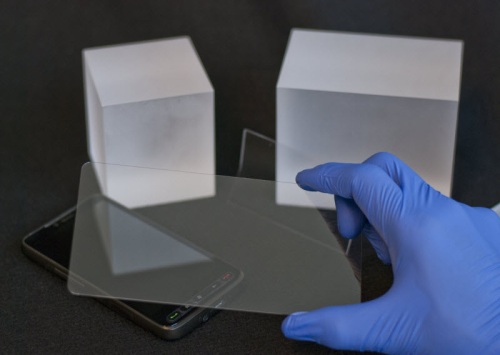Synthetic sapphire is a crystalline form of aluminum dioxide — other than diamond, there is no other material as durable as it.

Synthetic sapphire could be used as a durable, scratch-free display cover for future generations of mobile devices.
While sapphire is an expensive material to manufacture, falling costs and improvements in manufacturing technology could bring this crack-resistant, scratch-proof material to market as the display screen for future generations of mobile devices.
Why Sapphire?
Gorilla Glass is used in a majority of mobile devices nowadays because the material is durable and cheap to manufacture (it costs just under $3 to create a display). Sapphire is not used because it’s difficult to create and costs about ten times as much to manufacture — approximately $30 per display.
In the past, this was enough to ward off most device manufacturers from even considering the material for their product; however, experts predict that this price will drop below $20 over the new few years due to improved manufacturing technology and an increase in competition.
And since sapphire is a much better product than glass, a sub-$20 manufacturing cost could be the benchmark that makes the material cheap enough to start competing in today’s display market.
Gorilla Glass vs. Sapphire
Since sapphire is the second most durable material in the world, it makes a pretty good case against Gorilla Glass in terms of durability. For those interested in numbers, the material proved in tests to be about three times stronger than Gorilla Glass, three times more scratch resistant, and has a melting point of 2,030 C.
That being the case, sapphire displays can easily resist a brush with car keys and have proven to withstand being dropped against an asphalt surface. In fact, the material has proven to perform so well that it’s actually used as transparent armor on some military vehicles and can be found in bulletproof glass as well as the front window of barcode scanners.
The most notable consumer product to feature sapphire glass is the iPhone 5, which uses the material to protect the phone’s camera.
While descriptions are good and all, there’s no better evidence than an actual demonstration. In the video below, an iPhone is retrofitted with a sheet of GT’s sapphire glass and put through a durability test:
Affordable Alternative Offers Promising Outlook
While it might be a while before the price to manufacture drops low enough that sapphire displays are used in all mobile devices, there are alternatives that can be used in the meantime. For instance, a manufacturer can use pure sapphire to laminate an ultrathin layer of the material with another, less expensive transparent material. This would allow the display to maintain much of the performance advantage of sapphire at a cost almost equal to manufacturing a glass display.
MIT’s Technology Review, which originally reported this story, provides a good example of a company that is already doing this: GT Advanced Technologies. The New Hampshire-based company has developed an efficient, cost-effective method for manufacturing sapphire sheets thinner than a human hair.
Specifically, they’ve incorporated the same economic strategy used to make crystalline silicon for solar cells aluminum oxide. First, they melt the aluminum dioxide down in the company’s specialized furnace. The material then slowly cools, whereupon it forms a large crystal.
The crystal itself is then removed from the furnace and cut into very thin sheets using a diamond-coated wire saw.
Other companies who’ve incorporated similar methodology to manufacturing sapphire include Rubicon Technologies (US), Monocrystal (Russia), and Sapphire Technology (South Korea).
To learn more about their product, visit the GT Advanced Technologies website.
Story via: technologyreview.com
Advertisement





